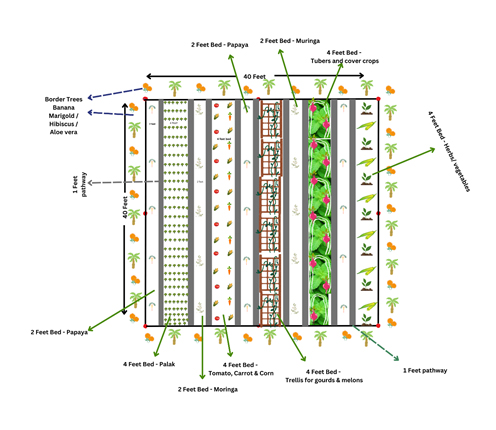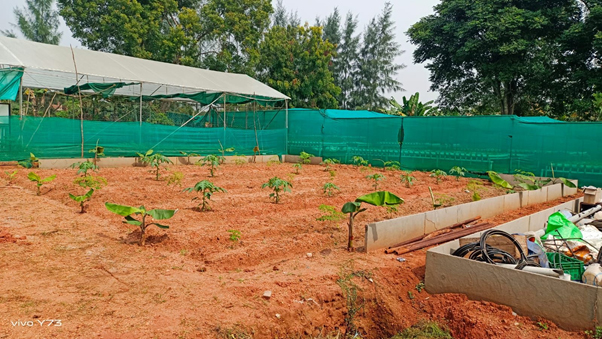Natural Precision Farming
Our Motto
To help convert a million acres of agricultural land to natural farming in next 10 years; and in the process, help 10,000 ex-soldiers, rural women and youth to become Natural Farming entrepreneurs.
Our passion lies in creating innovative solutions for vibrant and thriving ecosystems.
What?
By mimicking the natural forest ecosystem, this model acts as a food production strategy in a small space. Food Forest Diversification is a key to agroecological transitions to ensure food security and nutrition while conserving, and enhancing natural resources. In alignment with Natural Farming practices, we try to adopt up to 7 layers of natural forest system into this;
In Natural Farming Soil Biology trumps Soil Chemistry.
It is all about:
-
- enriching soil / growing medium for high microbial density and health.
- Increasing plant roots’ capacity to absorb nutrients.
- Improve nutrition through foliar sprays and balanced organic nutrients, through the life cycle of the plants.
- Take care of pests through organic and natural pest management solutions.
With combined knowledge of Permaculture, Agroecology, Regenerative Agriculture and Small-scale Integrated Sustainable Biological Farming practices such as SBNF, We embarked on the journey of transforming a barren 1600 -square-foot plot of land (exactly 40ft*40ft) into a flourishing food forest. This project showcases the immense potential of food forests in various settings, from small-scale gardens to expansive acres of land.
We are applying this model in few farms and generating healthy and good quality produce:
- Poothurai farm
- AVA farm
- Gratitude farm
- Asefa farm
- Auroville farm
- Pooriampakkam
Here is one of our project – at Gratitude Farm near Pondicherry :
The journey began with clearing the land in mid of August in 2022 and enriching the soil through multigrain sowing and ploughing for two months. To maximise efficiency and diversity, I divided the beds into sections: 2-foot beds for tree saplings and 4-foot beds for seasonal plants like vegetables, creepers, greens, and tubers. Along the borders, we established a complementary banana plantation with marigold and lemongrass intercrops. Careful selection of tree crops such as Papaya and Moringa, along with seasonal crops like long beans, tomato, and spinach, ensured thriving growth in the tropical climate. We have Moringa, Papaya, Curry leaves, Banana along with other border and seasonal plants.
Within just 10 months, the food forest flourished with vibrant life! It was immensely gratifying to witness its rapid growth and productivity, highlighting the potential for this model to provide multiple benefits. This food forest embodies the four pillars of sustainability. From a social perspective, it generates employment opportunities and serves as a source of livelihood for farm workers. Economically, it ensures a steady yield of diverse produce, providing a sustainable income stream. Furthermore, the food forest plays a vital role in environmental conservation by maintaining biodiversity within the farm ecosystem. Lastly, it promotes holistic well-being by supplying an abundant variety of greens, vegetables, fruits, flowers, stems, and tubers, thereby meeting the nutritional requirements of families and communities. I am excited to share some captivating photographs documenting the transformation and growth of the food forest. These images capture the essence of a sustainable and regenerative agricultural system that holds immense promise for our collective future.
Let’s come together to create thriving, biodiverse, and resilient agricultural systems for generations to come.


